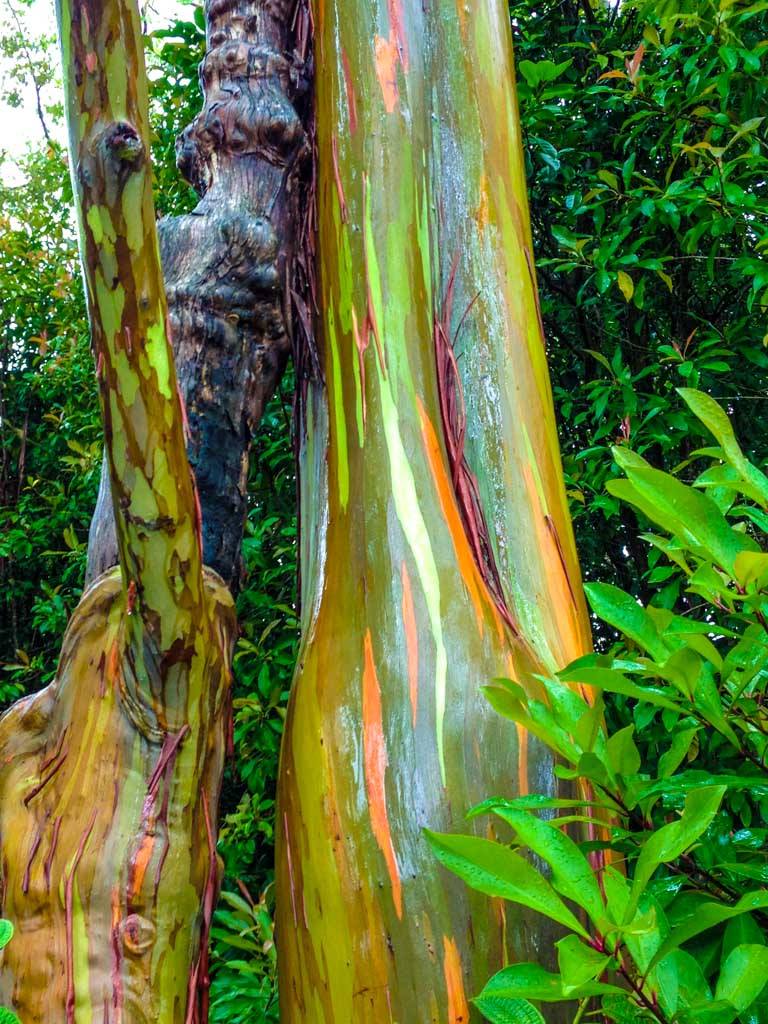
Maui Rainbow Eucalyptus
Maui is a tropical paradise like no other in the world
Even when compared to the other Hawaiian islands, Maui stands out as unique. Thus the term “Maui No Ka Oi” (which means Maui is the best) has become a common and well known local term used to describe the island – it even has it’s own hashtag!
One of the most amazing areas of Maui is the road to Hā na. Whether you drive yourself or enjoy a relaxing Hana tour there is something special in the Hana rainforest that you should stop and see… the Rainbow Eucalyptus tree!
Rainbow Eucalyptus Origins
These trees may look like they’ve been painted on, but these colors are all natural. This spectacularly colored tree is called Eucalyptus deglupta, and also known as the Mindanao Gum or the Rainbow Gum tree. The multi-colored streaks on its trunk comes from patches of outer bark that are shed annually at different times, showing the bright-green inner bark. This then darkens and matures to give blue, purple, orange and then maroon tones.
Eucalyptus deglupta is the only Eucalyptus species found naturally in the Northern Hemisphere. It is native to Philippines but has been introduced and grows well in Indonesia, Papua New Guinea, New Britain, and Hawaiʻi. This tree is cultivated around the world and is harvested mainly for pulpwood used in making paper, especially in the Philippines. It is also for ornamental landscaping purposes. It grows rather quickly – averaging around 6 feet per year and can reach heights of up to 200 feet high and 95 inches in diameter!
Introducing Rainbow Trees To Maui
Humans have been introducing plants to Hawaiʻi for centuries. In ancient times our island was revered for it’s abundance and sustainable Hawaiian lifestyle. The first people to arrive in Hawaiʻi from polynesia brought several plants and animals with them. Many like the breadfruit tree, wild boar and sweet potatoes complimented the naturally occurring taro, sugar cane and fish which sustained many generations for hundreds of years.
Since the islands were discovered by European explorers in the late 1700s many more plants, animal and tree species from around the world have been introduced to Maui. Eucalyptus trees were originally planted as a wood burning fuel source for sugarcane production and are now known as an invasive species especially on the slopes of Haleakala. The Rainbow Eucalyptus tree was first planted in Hawaiʻi 1929 at Oʻahu’s Wahiawa Botanical Gardens as part of Hawaiʻi’s reforestation efforts. Exactly how the rainbow (also known as painted gum) eucalyptus became introduced to the rainforest of Hana is unknown, but some speculate it was planted in the 1930s to control soil erosion due to over logging.
Many of the trees you see in the rainforests along Hana highway were introduced for various reasons. For example, you will notice the bamboo forests which were planted by Chinese workers who helped build the Hana highway in the 1920s. It was used for building scaffolds and housing.
Road To Hāna Rainbow Trees
The most well known grove of rainbow eucalyptus on Maui is located near mile marker 7 along the Hana Highway but these beautiful trees are scattered at several other locations including Ke’anae Arboretum and spots just before Hana town. They can be hard to spot in the dense rainforest so if you really want to be sure to experience these amazing trees up close try going on a road to Hana tour. A guide can safely show you where this and many more treasures along the road to Hana are. Hana Ho!
There are many stories about the Rainbow Eucalyptus trees which are found all over the island but are mainly seen on the slopes of Haleakala. I was told by a Haleakala ranch hand that they were originally planted as a source of lumber and fuel for the sugarcane industry and as an erosion deterrent after the sandalwood trade laid bare the slopes of Haleakala. Between 1934 and 1941 over 1 million trees were planted by the CCC (civilian conservation corps) throughout the state. They didn’t work out as lumber because Maui’s trade winds would whip them during their fast growing cycle which caused the trees wood grain to twist to the point of making it difficult to produce straight lumber. Another “twist of fate” is that being originally from Australia they had evolved to absorb as much water as possible from the arid outback. When the trees were introduced to Hawaiʻi they went to work sucking up approximately 100 gallons of water per day, drying out the soil and depositing oils that deterred water absorption in a one two punch to the land. Today they grow monstrously big and heavy and are difficult to control. These trees grow as large patches on the slopes of Haleakala that can be seen from miles away.
Skyline Eco-Adventures built the first zipline course in the U.S. within one of these Eucalyptus forests at about 4000’ elevation along Crater Road in upper Kula. For them these trees make for great zipline anchors but the company also saw the problems these trees cause to the native forest. Since their beginning in 2002 they have planted hundreds of native Koa and Ohia trees along the zipline course and continue to do so today.
Despite the Eucalyptus trees invasiveness they are quite beautiful and make for a wonderful smelling forest. The oils are medicinal and I like to pick the tops off of young trees to use as bouquets that make for a calming air freshener in my house. Along the road to Hana grows one of the most beautiful examples of this species planted on Maui, the Painted Gum Eucalyptus.









